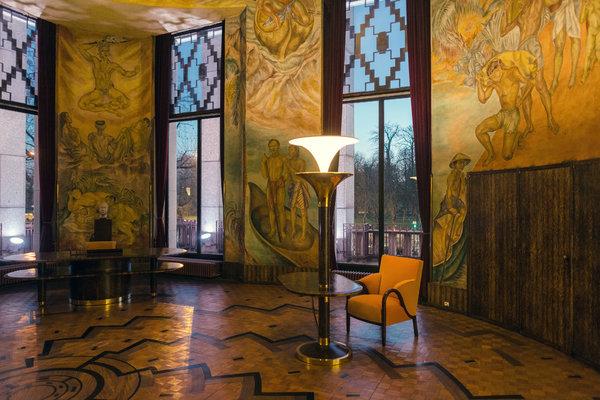PARIS — When the shoe designer Christian Louboutin was a boy growing up in eastern Paris, he would while away hours in the Palais de la Porte Dorée, an Art Deco building then used as a museum of the indigenous arts of Africa and Oceania, with an extensive aquarium in the basement. The museum, which designed by Albert Laprade for the Paris Colonial Exposition of 1931, had two oval rooms bookending the hall — one dedicated to Africa, the other to Asia. And next to their entrances hung a sign with a woman’s foot in a stiletto pump crossed by a red bar: No high heels.
Piqued by the image, Mr. Louboutin began doodling similar shoes. A fetish — and a career — were born.
About 18 months ago, Mr. Louboutin was recounting this story to France’s head of patrimony, the television personality Stéphane Bern. “That museum needs restoring,” Mr. Louboutin said Mr. Bern told him. “Things are wearing out. Call them.”

The Asian hall, with frescoes depicting the flora, exotic fauna and the people of France’s former colonies.CreditDmitry Kostyukov for The New York Times
So Mr. Louboutin did. And he told the museum’s director, Hélène Orain, that he wanted to underwrite a major renovation.
“How wonderful!” she said.
His donation — he would not reveal the amount except to say it was “expensive” — has financed an overhaul of the grand hall, the atrium, the two oval rooms and the library, which contains screens by Jean Dunand, one of the most respected lacquer artists of the Art Deco era. Teams of restorers cleaned the frescoes, parquets and mosaic floors in the main spaces, and artisans with the Mobilier National, a government service agency that oversees décor in public buildings, restored the furniture.
“This museum is a masterpiece for its décor, of course,” Ms. Orain said, as she gave Mr. Louboutin a tour of the finished rooms last week. The white-piped tobacco leather and ebony chairs in the Africa room were designed by the Art Deco master Émile-Jacques Ruhlmann. The Asia room’s four cantilevered desks, in Gabon palm wood and bronze, were made by the master woodworker Eugène Printz.
But the building “also tells the story of colonization and tells it properly,” she continued. “We were a colonizing country — we must own up to that. The museum recounts what colonizing was about: beauty and desire — the desire of the other, and the domination of the other.”
It owns up to it now through exhibitions (The building had been repurposed in 2007 as the Museum of Immigration History after its permanent collection moved to the then-new Quai Branly Museum in the 7th Arrondissement) and through its original decoration. The walls of the oval salons are covered with colorful frescoes of tropical flora, exotic fauna and the people of France’s African and Asian colonies. The two-story ballroom-like atrium is decorated with an even grander four-wall fresco, by Pierre Ducos, titled “France and the Five Continents.” It depicts fleets of billowing-sailed tall ships and scenes of Western sciences, humanities and medicine. “What we, the French, thought was the goodness we were bringing to the colonies,” Ms. Orain said.
Mr. Louboutin said he felt that the museum “honors and celebrates diversity.”
Attention was paid to the exterior, too, during the renovations, including a buffing up of the iron front gate, made up of rows of small gold pyramids, like sharks’ teeth. It was created by Jean Prouvé “when he was 18 years old,” Mr. Louboutin said. “Incredible, no?” Prouvé went on to become one of the midcentury’s design giants.
Most dramatic, however, is the effect of new computer-controlled LED lighting on the building’s 625-foot bas-relief facade, which Ms. Orain said is the longest in Europe. Designed in 1929 by Alfred Janniot, the French sculptor who also created the gilded panel front of the Maison Française at Rockefeller Center in New York, the mural “tells the history of the whole world — animals, plants, water and man,” Ms. Orain explained.
“Janniot loved cinema, and everyone and everything on the facade is in motion, like in a movie,” she said. “Thanks to Christian’s donation, you can clearly see it now.”







